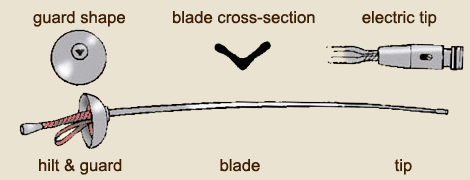FAQ
FENCING CAN BE CONFUSING for people who are new to the sport. Hopefully this page will clear up some of your queries, but if you still have any questions, your coach and club committee members are a veritable wealth of information, and they just love talking about fencing stuff. Seriously, you'll have a hard time shutting them up about it once they get going...
Foil








The foil is a light thrusting weapon with a hit triggering force of 500g. The foil target for scoring is the torso only. The foil has a small circular hand guard that serves to protect the hand from direct hits. As the hand is not a valid target in foil, this is primarily for safety. Touches are scored only with the point. Touches that land outside the target area (called a non-valid touch and signalled by a distinct colour on the scoring apparatus) stop the action, but are not scored. Only a single touch can be awarded to either fencer at the end of a phrase of action, thus the referee uses the rules of priority (right of way, or RoW) to determine which fencer is awarded the touch. If the referee is unable to determine which fencer has right of way, no touch is awarded.
Epée
The epée is a thrusting weapon like the foil, but heavier, with a hit triggering force of 750g. In epée, the entire body is valid target. The guard on the epée is larger than in foil and extends towards the pommel, effectively covering the hand. As the entire body is legal target, there is no concept of a non-valid touch. Unlike foil and sabre, epée does not use priority ruling, and can award simultaneous touches to both fencers.






Sabre
The sabre is a light cutting and thrusting weapon that targets the entire body above the waist, except the weapon hand. Like the foil, the maximum legal weight of a sabre is 500 grams. The hand guard on the sabre extends from hilt to the point at which the blade connects to the pommel. Hits with the entire blade or point are valid. As in foil, touches that land outside the target area are not scored; however these non-valid touches do not stop the action. In the case of both fencers landing a scoring touch, the referee determines which fencer receives the point for the action, again through the use of priority.








Equipment:
Because of the contact nature of the sport of fencing, adequate protective gear is required before you can face other competitors. Some equipment is rated (in Newtons of force) to ensure its resistance to puncturing; the standard ratings are 350N (club standard) & 800N (international standard). Any equipment branded with the FIE (Fédération Internationale d'Escrime) symbol is rated at the 800N standard or higher. A fully uniformed fencer is almost entirely covered, with only their non-sword hand and back of head exposed!




Chest Plate: Also known as chest protector, body protector or BP, this piece is mandatory for females as it provides rigid protection for the upper chest. Male fencers can also wear one if they wish. The AHFC recommends all young fencers use them, regardless of gender or weapon type.
Plastron: This garment goes under the jacket, upon the sword arm for extra protection. The plastron has a gusset which ensures a solid patch of material beneath the jacket's seam.
Jacket: The jacket covers the whole upper body,from groin to throat and wrists, and includes certain safety features such as the side/back zip, and protective catch at the collar.
Glove: The glove is needed to protect the sword hand. Available as unrated or FIE
Mask: This is what protects the face from the opponent's weapon. The mask consists of a wire mesh and bib to protect the face and neck area. The FIE standard for masks is 1600N!
Bodycord/wire: The wire goes under the jacket. This is what connects the weapon to the scoring system.
Lamé: Pronounced Lah-May, lames are used to denote target area in Foil and Sabre; to register valid hits by completing a circuit and sending a signal back to the scoring box.
